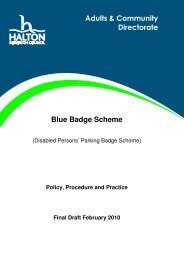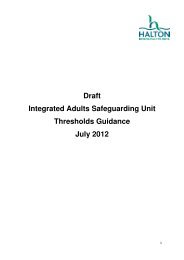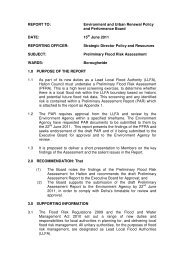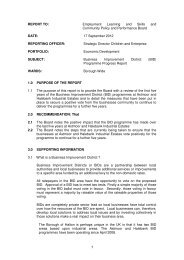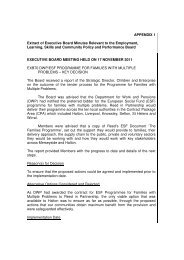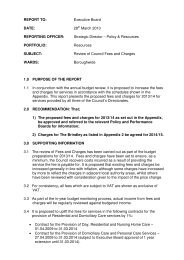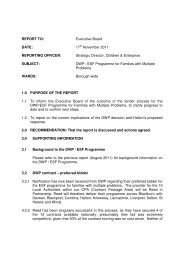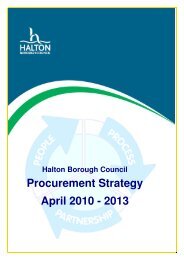Transport Asset Management Plan - Halton Borough Council
Transport Asset Management Plan - Halton Borough Council
Transport Asset Management Plan - Halton Borough Council
You also want an ePaper? Increase the reach of your titles
YUMPU automatically turns print PDFs into web optimized ePapers that Google loves.
<strong>Halton</strong> <strong>Borough</strong> <strong>Council</strong><br />
<strong>Transport</strong> <strong>Asset</strong> <strong>Management</strong> <strong>Plan</strong><br />
Arrangements for the management of highway maintenance need to be set within the context of an<br />
overall asset management regime. The development of a Highway <strong>Asset</strong> <strong>Management</strong> <strong>Plan</strong> (HAMP)<br />
is fundamental to demonstrating the value of highway maintenance in delivering the wider objectives<br />
of corporate strategy, transport policy and value for money. Highway asset management is however<br />
only one component of a much wider range of functions and services provided within the<br />
Environmental remit.<br />
Well-maintained local transport assets, including roads, footpaths, bridleways and cycle paths, are<br />
essential to the delivery of better transport outcomes. The theme of asset management is<br />
strengthened by Government guidance encouraging local authorities in England to draw up <strong>Transport</strong><br />
<strong>Asset</strong> <strong>Management</strong> <strong>Plan</strong>s (TAMPs) as part of the second round of LTP preparation consistent with the<br />
advice contained in the CSS Framework document. The definition of a <strong>Transport</strong> <strong>Asset</strong> <strong>Management</strong><br />
<strong>Plan</strong> is essentially an extension of the more basic HAMP and the terms have become largely<br />
interchangeable. References to both HAMP and TAMP within this document should thus be read as<br />
being mutually supportive.<br />
The TAMP enables Highway Authorities to document the effects of under funding on the levels of<br />
service provided and allows an assessment of the concurrent risk resulting from such action.<br />
The definition brings together a number of themes that define the approach that an authority should<br />
take. These are: -<br />
Strategic Approach: A systematic process that takes a long term view;<br />
Whole of Life: The whole –life /life-cycle of an asset is considered;<br />
Optimisation: Maximising benefits by balancing competing demands;<br />
Resource Allocation; Allocation of resources based on assessed needs;<br />
Customer Focus; Explicit consideration of customer expectations;<br />
1.2.2 Scope of the <strong>Transport</strong> <strong>Asset</strong><br />
In <strong>Halton</strong>, our <strong>Transport</strong> <strong>Asset</strong> consists of roads, bridges, footways, street lighting, signs, bollards,<br />
traffic signals, highway drainage, road markings, cycle ways, public rights of way, cycle-ways, bus<br />
signs and shelters and also includes a variety of associated structures such as retaining walls and<br />
culverts. We do not have responsibility for trunk roads and motorways, which are the responsibility of<br />
the Highways Agency, foul drainage looked after by United Utilities, or un-adopted roads and<br />
structures the responsibility of a variety of private organisations, Public Bodies and Private individuals.<br />
FinalversionLprovisional0.doc 8






